Thank you for sharing the coastal love:
For your convenience this post may contain affiliate links. If you make a purchase I may earn a small commission, at no additional cost to you. I'll probably blow it on a cheapo pair of flip-flops or bottle of wine :-)
Cover Photo by Catrin Johnson
The coast of Florida, and more so the west coast, is perhaps the best place in the United States for shelling and beachcombing.
We’ve identified 15 of the best beaches to find a variety of colorful and interesting sea shells and sea glass for the eager and serious sheller. It’s worth noting that each beach attracts different shells and the selection on any given beach changes from day to day.
Shelling and Beachcombing
The modern meaning of shelling and beachcombing is the leisurely act of strolling along the seashore and “combing” (searching) for and gathering interesting items that have washed in with the tide — sea shells, driftwood, sea glass, etc.
Years ago the practice of beachcombing fell to those who were destitute or with scant means. A “beachcomber” became “synonymous with a criminal, a drifter, or a bum.” (Wikipedia) I wonder if this is where the term “beach bum” came from?
In her book Yesteryear I Lived in Paradise, Myrtle Scharrer wrote about her beachcombing experiences growing up on Caladesi Island in the early 1900s.
“If there had been a winter blow, the beach would be newly covered with colorful shells of all kinds. Sometimes there was real treasure to be found . . . a rare junonia, for which . . . a shell dealer would pay ten dollars.” And “sometimes timber washed in—things that could be used for dock repairs and other uses.” Myrtle saw these things as “gifts from the sea.”
Anne Morrow Lindbergh in her memoir, A Gift from the Sea, “shares her meditations on youth and age; love and marriage; peace, solitude and contentment as she set them down during a brief vacation by the sea. Drawing inspiration from the shells on the shore, her musings on the shape of a woman’s life bring new understanding to both men and women at any stage of life” (Goodreads)
How to practice shelling and beachcombing
Best time to go shelling
Timing is everything for finding the best shells. Start your beachcombing early in the morning, at sunrise or before, to have a first pick of what Mother Nature has washed ashore. Ideal shelling and beachcombing time is at low tide after a period of strong winds.
The area just above the high tide line is a good place to look for shells. It’s usually marked by a row of seaweed, salt marsh and other debris brought in by the high tide, called “wrack”.
Wrack might be a thin and irregular line of seaweed, sticks and shells, or it can be more than a foot-deep. Within the wrack can be a variety of seaweed, shells, sponges, carcasses of shellfish, and other marine life as well as driftwood pieces, buoys, rope, sea traps (lobsters, crabs), boat pieces and more. Today it’s important to carefully pull apart the wrack to avoid broken glass and other hazardous items.
You should never remove live shells from beaches. These shells having living organisms still inside. Sand dollars that are found in the water are most likely alive. (see our post Fascinating Facts and Legends of the Sand Dollar).
What to wear shelling
It’s best to dress in loose and comfortable clothing as you’ll be bending over A LOT. A wide brim hat and sunscreen wouldn’t hurt either, especially if you’re fair-skinned and prone to burning.
Should you be shelling during the brightest time of the day, you’ll want a pair of polarized sunglasses. The glare at the water’s edge can get harsh.
Fair warning: Wear something on your feet, like these water shoes. Some of the beaches on Florida are so jam packed with shells that beachcombing barefoot isn’t recommended. There’s nothing worse than stepping on broken shells.
Beachcombing Tools
Of course all you need is your two hands to collect shells but a Sand Scooper is a nice tool to make shelling easier on your back.
Grab a mesh bag (a recycled onion sack works great) or pail and get shelling! Consider taking a pill bottle to hold extra tiny wentletraps (a.k.a. staircase shells).
Here’s a list of the best shelling and beachcombing beaches in Florida to find your sea treasures:
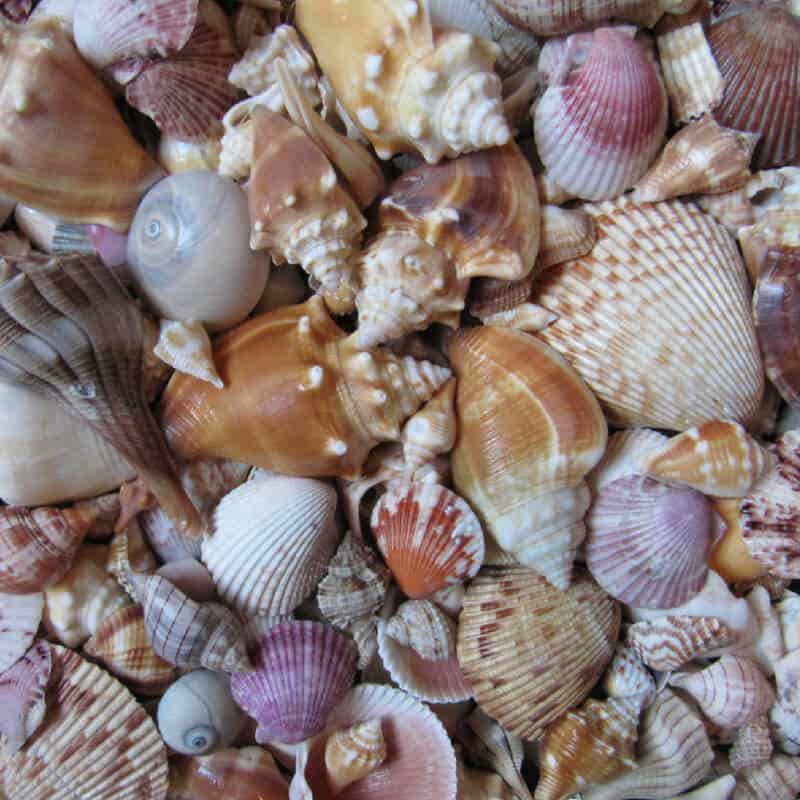 Sanibel Island Sea Shells image via © Jodi Diehl
Sanibel Island Sea Shells image via © Jodi Diehl
Located near Fort Myers, Sanibel Island is one of the best places in Florida for collecting seashells. On this barrier island, shells cover the beaches. The island is also appealing for its wildlife, great restaurants, and low-key development. Here you can expect a quiet, leisurely trip full of good walks on the beach.
Known as the “Shelling Capital of the World”, Sanibel is by far the most popular destination in Florida for shelling. Its unique barrier island terrain allows shells to be washed up ashore throughout the year, where shell lovers do the “Sanibel Stoop” and discover pastel coquinas, junonia and lightning whelks. Head to Blind Pass Beach on Sanibel or take a trip to nearby Cayo Costa State Park on Captiva Island.” (source: Sanibel Island website)
The best shelling is found on the beaches of Sanibel Island and Captiva Island. The islands rank tops in the world for shelling because of its geography. The curve shaped Sanibel Island is along the coastline among a string of other more orderly, straight-and-narrow islands. The east-west location of Sanibel’s south end acts like a shovel scooping up all the seashells that the Gulf brings in from the Caribbean and other southern seas.
As a general rule smaller seashells are found on the Lighthouse end of the island chain and the larger shells nearer Captiva and North Captiva.
Among the species you may expect to find while shelling:
- Conch
- Junonia
- Lightning Whelk
- Cockle
- Scallops
- Murex
- Tulip
- Olive
- Coquina
(source: Sanibel Island Beach Treasures)
Visit Sanibel Island, Florida.
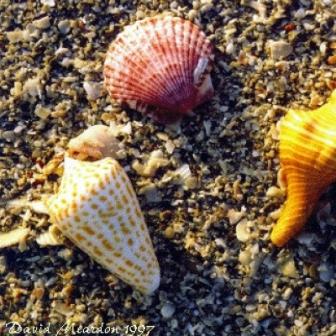 Captiva Island, Florida sea shells image via David Meardon
Captiva Island, Florida sea shells image via David Meardon
Captiva Island is noted as one of the very best places in the state of Florida for collecting shells. It is a regular and recurring destination of serious shell collectors. I happened upon Sanibel and Captiva Islands several years ago while visiting Fort Myers during baseball spring training. Some of my favorite shells are from both places. In the northeast the sand dollars are one-quarter the size as the ones I found on Captiva Island. There were just too many to take home!
Visit Captiva Island, Florida.
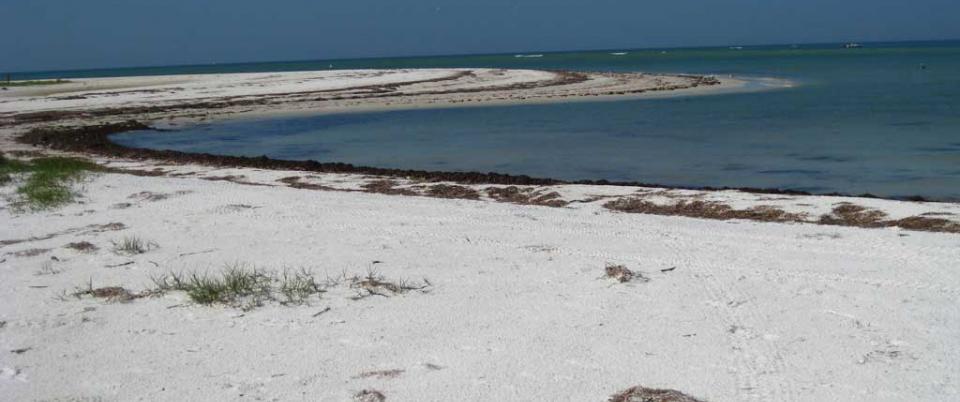 Caladesi Island near Tampa, Florida image via Lori Keene Shore
Caladesi Island near Tampa, Florida image via Lori Keene Shore
If you’re looking for protected state beaches, plan a trip to the Caladesi Island State Park in the Tampa Bay Area. You can’t reach this beach by car — only by boat — leaving the quiet beach yours to explore. There are great shells here and it is a popular spot for swimming and picnics too.
“As one of the few completely natural islands along Florida´s Gulf Coast, Caladesi´s white sand beaches were rated America’s Best Beach in 2008. Beach lovers can enjoy swimming, sunbathing and beachcombing. Saltwater anglers can cast a line from their boats or surf fish. Nature enthusiasts can spot wildlife while hiking the three mile nature trail through the island’s interior or paddling a three mile kayak trail through the mangroves and bay. ” (source: (text floridastateparks.com)
Visit Tampa, Florida.
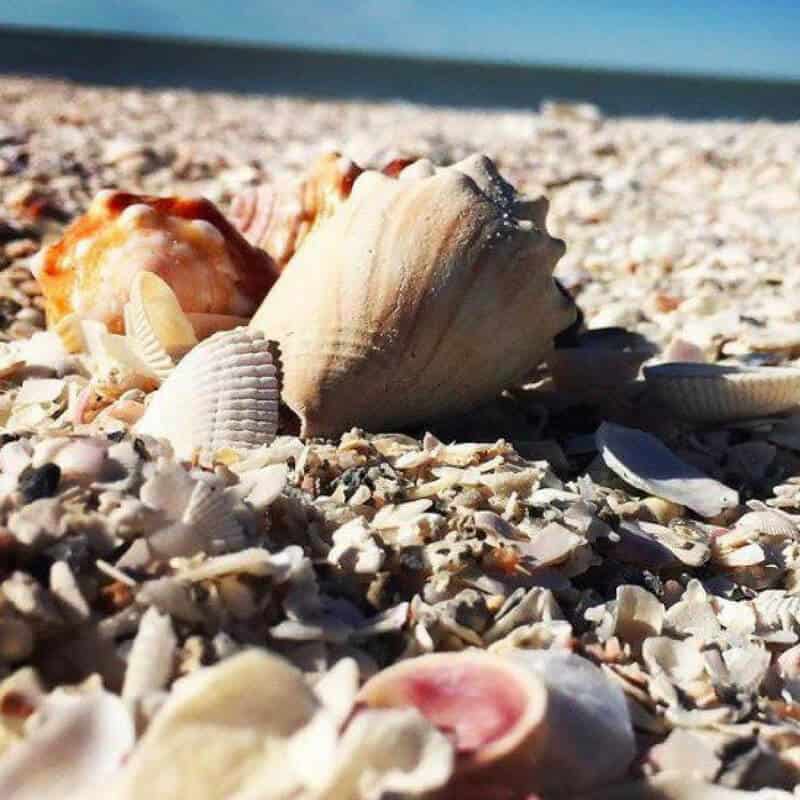 Cedar Key, Florida shells image via Facebook
Cedar Key, Florida shells image via Facebook
Another option on the Gulf Coast is Cedar Key. Located about 50 miles southwest of Gainesville, Cedar Key is known as “Old Florida”. This beach is especially great at low tide when you can explore all the tidal pools for shells. The fact that you need a boat to reach this small island also means fewer crowds on the beautiful beach.
Visit Cedar Key, Florida.
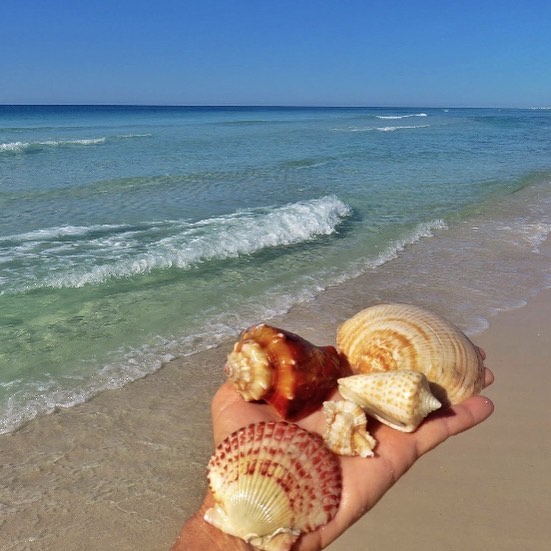 Panama City Beach, Florida image via Instagram
Panama City Beach, Florida image via Instagram
There is also some great shelling in Florida’s Panhandle region. Shell Island, which isn’t an island but rather a peninsula off Panama City Beach, is an approximately 7-mile long undeveloped barrier island running east to west between the Gulf of Mexico and the St. Andrew Bay. Access to the island is by shuttle boat, private boat or tour boat.
Visit Panama City, Florida.
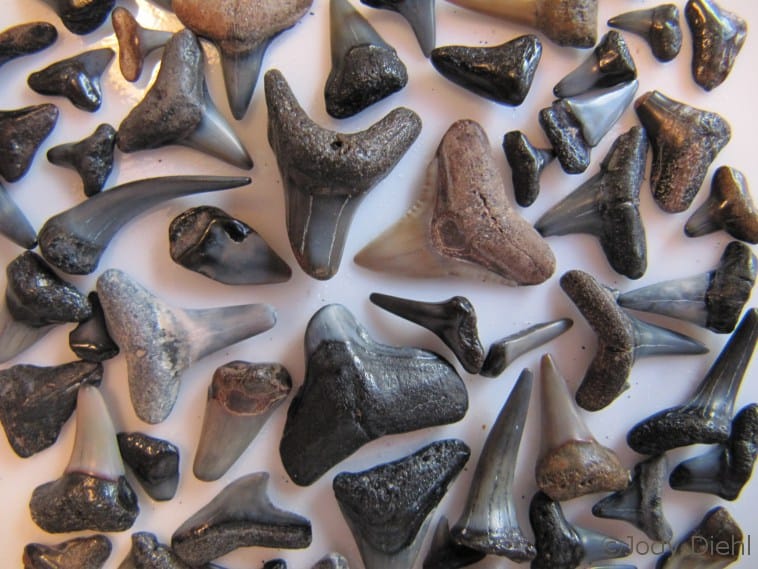 Shark Teeth found on Venice Beach, Florida image via beachtreasuresandtreasurebeaches.com
Shark Teeth found on Venice Beach, Florida image via beachtreasuresandtreasurebeaches.com
If you’re on the hunt for shark’s teeth, check out Venice Beach just south of Sarasota. Pretty cool!
Visit Venice Beach.
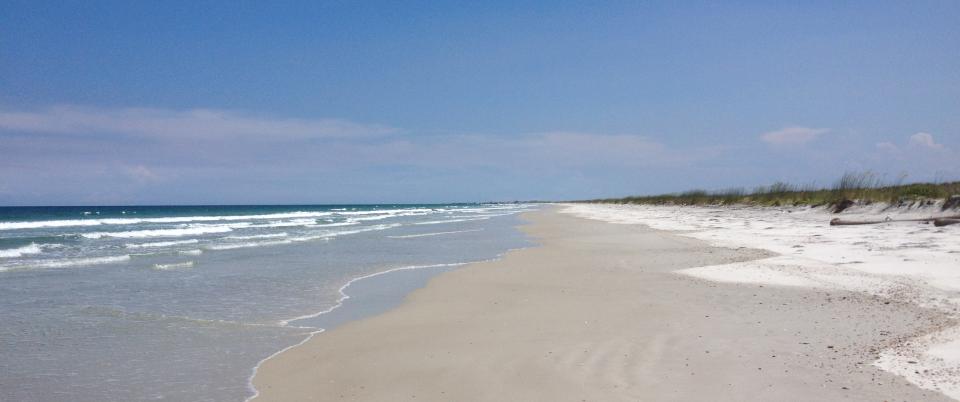 Little Talbot Island near Jacksonville, Florida image via Florida State Parks
Little Talbot Island near Jacksonville, Florida image via Florida State Parks
One great option on the Atlantic Coast is Little Talbot Island State Park, located north of Jacksonville. This beach is known for being the home to dozens of shell varieties. While many visitors congregate around the boardwalks looking for shells, you will have a more serene experience if you venture north to the long stretches of empty beaches.
Visit Jacksonville, Florida.
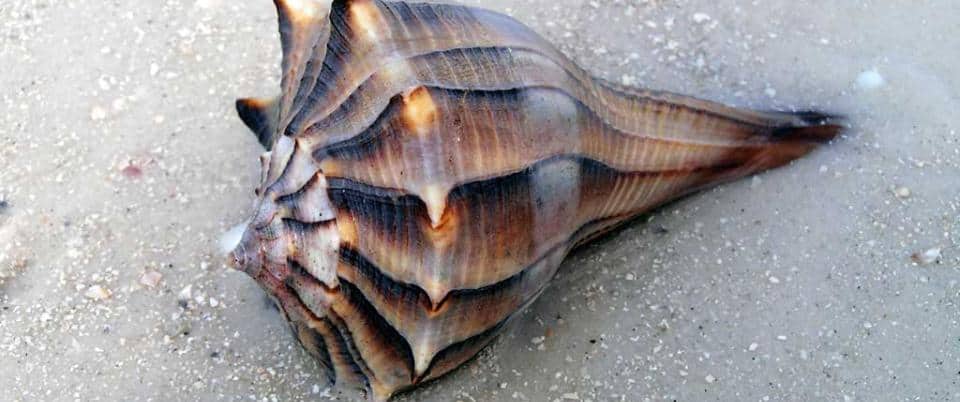 Honeymoon Island near Tampa, Florida. Sea shell image via Christina Rueb
Honeymoon Island near Tampa, Florida. Sea shell image via Christina Rueb
Another beach near Tampa for shelling is Honeymoon Island. Hunt for sand dollars and other interesting shells. The clear waters on the Gulf Coast make it possible to look for shells not just on the beach, but within the first few feet of where the water meets the beach as well.
Visit Honeymoon Island in Dunedin, Florida
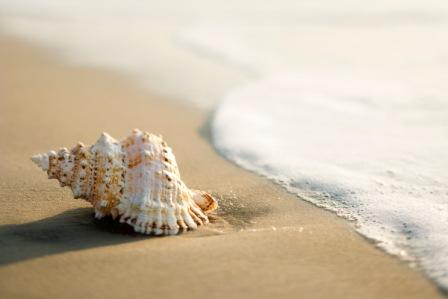 Conch Shell on Jupiter Beach, Florida
Conch Shell on Jupiter Beach, Florida
Located north of West Palm Beach on the Atlantic side, Jupiter Island also has a large variety of shells. Coral Cove State Park is on Jupiter Island and over 200 varieties of shells have reportedly been found here. By paying the entry fee you are also ensuring the beach will be preserved for future generations. (source: http://townofjupiterisland.com/)
Visit Jupiter Island, Florida
Fernandina Beach is located on Amelia Island off the northeast coast of Florida. This is another beach popular for shark’s teeth. Expect to sort through piles of shells to find unbroken, colorful, or other special shells.
Visit Amelia Island, Florida
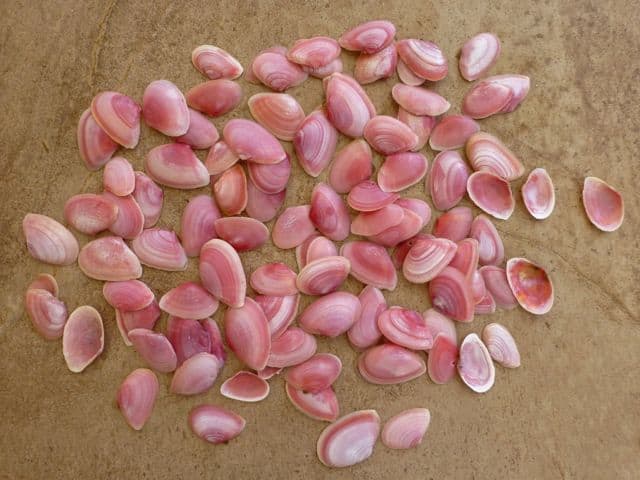 Rose Tellins (Pink sea shells) at Lovers Key in Fort Myers, Florida
Rose Tellins (Pink sea shells) at Lovers Key in Fort Myers, Florida
Lovers Key is a 2.5-mile stretch of beautiful beach along the Gulf of Mexico. This beach offers some of the best shelling opportunities on the Lee County coast. I gathered a bucketful of various shaped and sizes of sea shells here. There was a posted chart at the entrance to the beach to identify possible shell finds. Live shelling and the collection of sea stars is prohibited.
Visit Fort Myers Beach, Florida
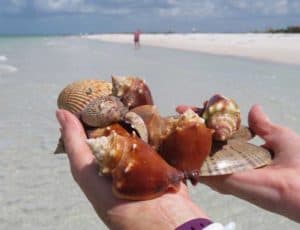 Sea Shells are easy to find in Marco Island, Florida. Image via David Blasco
Sea Shells are easy to find in Marco Island, Florida. Image via David Blasco
You’ll get a bucketful of shells here in a matter of minutes. So if you’re an impatient shell collector this is a great place for you!
Visit Marco Island, Florida.
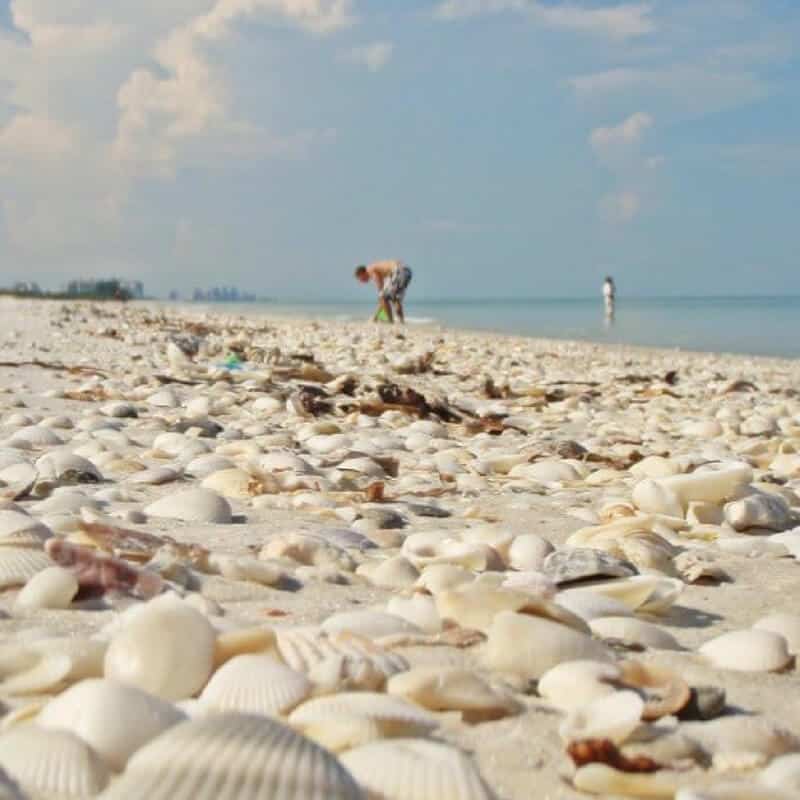 Don’t walk barefoot at Barefoot Beach in Naples, Florida. Image via Meghan.
Don’t walk barefoot at Barefoot Beach in Naples, Florida. Image via Meghan.
Barefoot Beach in Naples is on many shell collectors radar. This 342-acre park makes for a fabulous day of treasure hunting. Look for corals, alphabet cone, arks, bonnets, bubbles, Conches and paws, from the tiny Kitten’s Paw to the giant Lion’s Paw. This area is quiet and secluded, and its long stretch of beach can be enjoyed with a day of swimming, camping, canoeing and kayaking. (source: visitflorida.com)
Visit North Naples, Florida
 Sea Shells galore. Image via Catrin Johnson
Sea Shells galore. Image via Catrin Johnson
A seven mile long stretch home to the cities of Bradenton Beach, Holms Beach and Anna Maria, Anna Maria Island is a favorite vacation and shelling spot.
Visit Bradenton Beach, Florida.
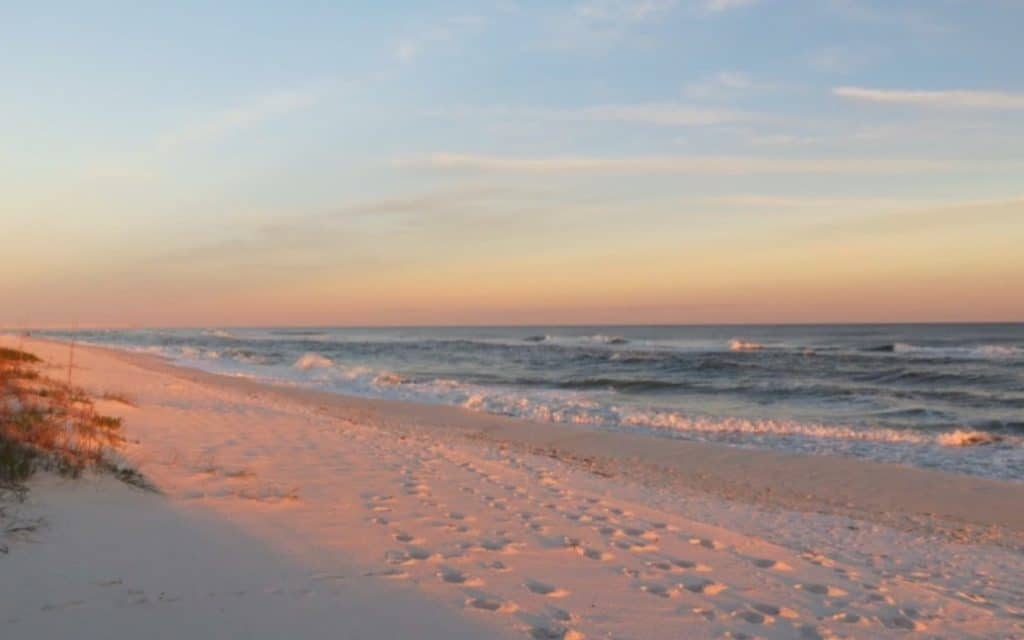 Navarre Beach, Florida
Navarre Beach, Florida
A compact beach community found just east of Pensacola at the far northwestern tip of the state, Navarre beckons with 12 miles of pristine white shoreline. Nestled between Gulf Islands National Seashore and Navarre Beach County Park, this beach community offers solitude and simplicity. (source: visitflorida.com)
Visit Navarre, Florida.
Go shelling and beachcombing in Florida
From the Gulf Coast to the Atlantic Coast, from busy beaches to hidden coves and secluded gems, Florida is home of great options for shelling and beachcombing. Get your bucket or mesh bag and head to the beach!
Related post: 12 Things (and more!) you must do when visiting Key West, Florida
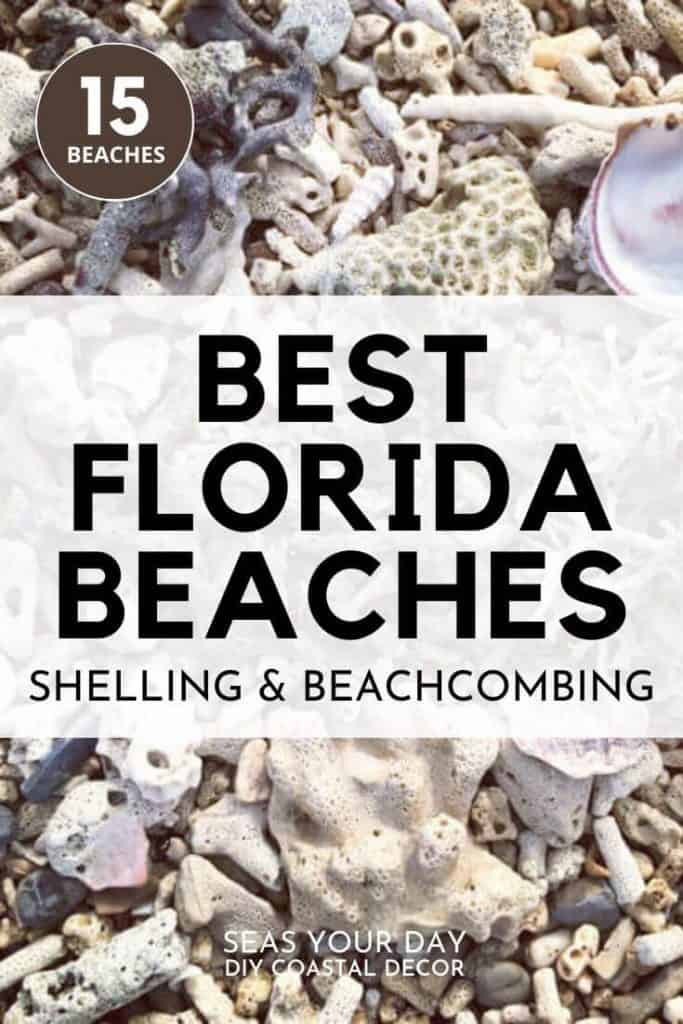
Thank you for sharing the coastal love: